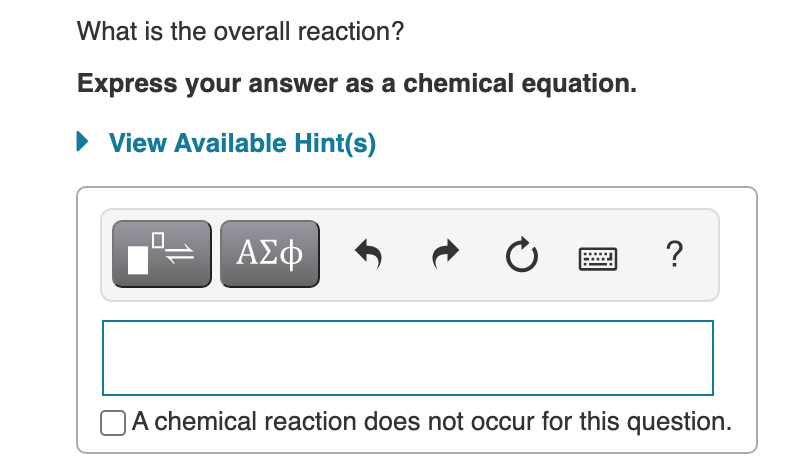What is the overall reaction? Express your answer as a chemical equation. • View Available Hint(s) ΑΣφ ? A chemical reaction does not occur for this question.
What is the overall reaction? Express your answer as a chemical equation. • View Available Hint(s) ΑΣφ ? A chemical reaction does not occur for this question.
Chemistry: The Molecular Science
5th Edition
ISBN:9781285199047
Author:John W. Moore, Conrad L. Stanitski
Publisher:John W. Moore, Conrad L. Stanitski
Chapter11: Chemical Kinetics: Rates Of Reactions
Section11.7: Reaction Mechanisms
Problem 11.12E
Related questions
Question

Transcribed Image Text:What is the overall reaction?
Express your answer as a chemical equation.
• View Available Hint(s)
?
A chemical reaction does not occur for this question.
![Order and rate law of a reaction
The overall order of an elementary step directly corresponds to its molecularity. Both steps in this
example are second order because they are each bimolecular. Furthermore, the rate law can be
determined directly from the number of each type of molecule in an elementary step. For example, the
rate law for step 1 is
rate = k[NO2]?
The exponent "2" is used because the reaction involves two NO2 molecules. The rate law for step 2
is
rate = k[NO3]'[C0]! = k[NO3][CO]
because the reaction involves only one molecule of each reactant the exponents are omitted.
Analyzing a new reaction
Consider the following elementary steps that make up the mechanism of a certain reaction:
1. 2X→Y+ Z
2. Y + 2L→M+Z](/v2/_next/image?url=https%3A%2F%2Fcontent.bartleby.com%2Fqna-images%2Fquestion%2Fb158f56a-86d6-40b2-b57e-d311cb867ac4%2Fc8b4aa13-ceb8-4231-ba69-9c24af033255%2F1mgyqtk_processed.png&w=3840&q=75)
Transcribed Image Text:Order and rate law of a reaction
The overall order of an elementary step directly corresponds to its molecularity. Both steps in this
example are second order because they are each bimolecular. Furthermore, the rate law can be
determined directly from the number of each type of molecule in an elementary step. For example, the
rate law for step 1 is
rate = k[NO2]?
The exponent "2" is used because the reaction involves two NO2 molecules. The rate law for step 2
is
rate = k[NO3]'[C0]! = k[NO3][CO]
because the reaction involves only one molecule of each reactant the exponents are omitted.
Analyzing a new reaction
Consider the following elementary steps that make up the mechanism of a certain reaction:
1. 2X→Y+ Z
2. Y + 2L→M+Z
Expert Solution
This question has been solved!
Explore an expertly crafted, step-by-step solution for a thorough understanding of key concepts.
This is a popular solution!
Trending now
This is a popular solution!
Step by step
Solved in 2 steps with 1 images

Recommended textbooks for you

Chemistry: The Molecular Science
Chemistry
ISBN:
9781285199047
Author:
John W. Moore, Conrad L. Stanitski
Publisher:
Cengage Learning

Chemistry for Engineering Students
Chemistry
ISBN:
9781285199023
Author:
Lawrence S. Brown, Tom Holme
Publisher:
Cengage Learning

Chemistry by OpenStax (2015-05-04)
Chemistry
ISBN:
9781938168390
Author:
Klaus Theopold, Richard H Langley, Paul Flowers, William R. Robinson, Mark Blaser
Publisher:
OpenStax

Chemistry: The Molecular Science
Chemistry
ISBN:
9781285199047
Author:
John W. Moore, Conrad L. Stanitski
Publisher:
Cengage Learning

Chemistry for Engineering Students
Chemistry
ISBN:
9781285199023
Author:
Lawrence S. Brown, Tom Holme
Publisher:
Cengage Learning

Chemistry by OpenStax (2015-05-04)
Chemistry
ISBN:
9781938168390
Author:
Klaus Theopold, Richard H Langley, Paul Flowers, William R. Robinson, Mark Blaser
Publisher:
OpenStax

Chemistry: An Atoms First Approach
Chemistry
ISBN:
9781305079243
Author:
Steven S. Zumdahl, Susan A. Zumdahl
Publisher:
Cengage Learning


Chemistry
Chemistry
ISBN:
9781305957404
Author:
Steven S. Zumdahl, Susan A. Zumdahl, Donald J. DeCoste
Publisher:
Cengage Learning